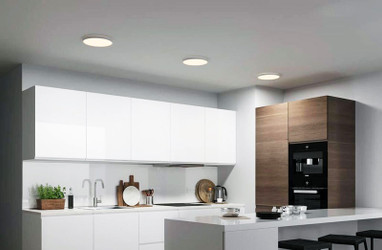Often called the heart of the home, the kitchen is one of the most used rooms within a home and is at the centre of a family’s everyday living. Your kitchen is a space that fosters family time, beautiful meals and laughter, some of the most important memories to a family. To ensure your kitchen is optimised for maximum use, lighting is an essential part in the designing and decorating of your kitchen. To achieve the perfect lighting within your kitchen, there are three types of lighting to consider: task lighting, accent lighting, and ambient lighting.
Different Types of Kitchen Lighting
Kitchen Task Lighting
Task lighting is exactly what it sounds like – lighting to help you complete tasks.
A kitchen is a multi-functional space that requires a combination of lighting efforts. However, for those specific tasks like cooking, cleaning and eating, task lighting is essential for adding those focused beams of light. When designing your kitchen, it’s important to consider which areas of the kitchen you will be carrying out these tasks and where your lights will be situated.
There are several lighting options available in order to achieve task lighting within your kitchen. Spotlights and pendant lighting are a common and effective lighting method for adding that extra illuminating light onto a specific area. Situating spotlights directly above task areas will help enhance the ambient lighting and make it easier for you to accomplish your tasks.
This can further be achieved through switch or motion sensors that can turn lights on and off, only coming to life when you need them. Nowadays kitchens can incorporate sensor lightings in countertops, cupboards and drawers.
Kitchen Accent Lighting
Accent lighting, also known as highlighting, is used to emphasise art or certain features, directed at anything you want illuminated.
Accent lighting is perfect for adding the finishing touches to your well-planned kitchen and creating that extra ambience and warmth. Accent lighting can be achieved by incorporating lighting into shelves or niches or adding a strip of LED lights behind an overhang. The same lights lower down at foot level can wash across the floor and make cabinetry look like it’s floating, as well as offering a beautiful nightlight. Commonly used for accent lighting are bar pendants, generally fitted above dining tables or breakfast bars.
Accent lighting is something that requires thought and planning as it has the ability to pull your kitchen design all together. A source of light but a stylish one at that, accent lighting is subtle but dramatic as it can bring your guests attention to those special features in your kitchen.
Ambient Kitchen Lighting
Ambient lighting is also known as general lighting that creates a base level of lighting in a room or space and can be functional or decorative.
Ambient lighting is commonly the main source of lighting within a kitchen, however, nowadays people tend to incorporate more task and accent lighting, resulting in less need for ambient lighting. This decision is completely up to you and your design preferences and you may find ambient lighting is essential within your kitchen.
Ambient lighting is commonly achieved through chandelier, pendant or flush ceiling lighting within the centre of a kitchen. Pendant lights are great for any kitchens with islands in the middle as they can be distributed in all directions or be focused solely on countertops. They are both stylish and functional.
When designing kitchens, many people start with ambient lighting first and then decide on adding task or accent lighting in.
Start Your Planning Early
Planning your kitchen is exciting but also overwhelming as there are so many elements to think about. Lighting needs to be considered as early as possible as once a kitchen is complete, it is harder to modify or add any changes to lighting, causing more disruption.
Our advice would be to look at the areas of your kitchen at the very start of your planning phase, think about what will happen in each space like your food prep or sink zones, which will need task lighting. Then consider your dining area, which will need mood and accent lighting. Research the different types of kitchen lighting available, then consider the size and layout of your kitchen and whether there is a lot of natural light coming through. You will then be able to work out which of the above kitchen lighting types will help create the perfect atmosphere for you.
We love to take stress off our customers when it comes to planning kitchen lighting, as we are experts and passionate about lighting, both functional and stylish.
We have thousands of different lighting fixtures for your kitchen, each with their own style, texture, and applications.
If you need help transforming your kitchen into something magical, then give us a call and one of our expert advisors will be happy to help.
 British Pounds
British Pounds
 Euro
Euro

